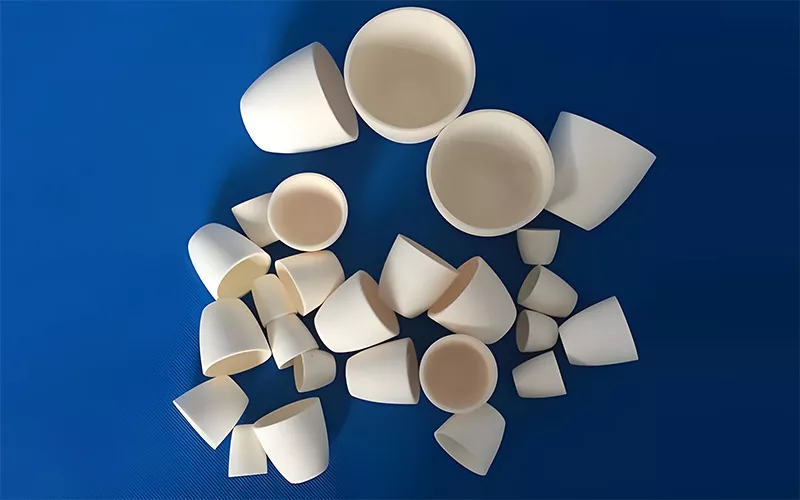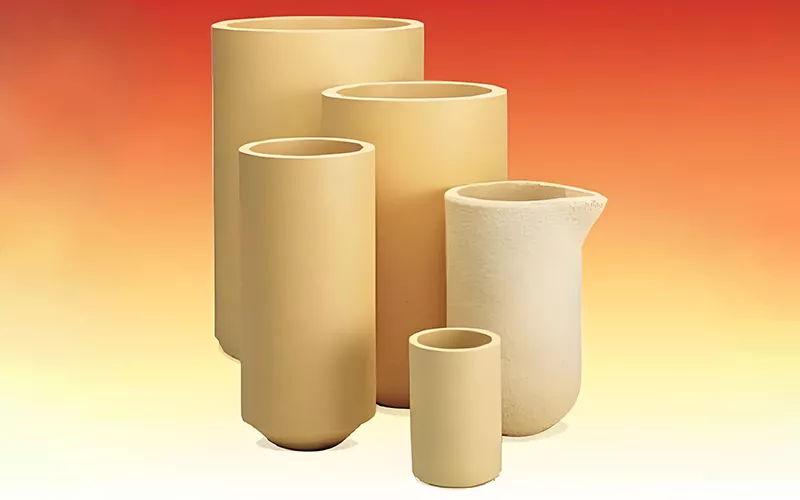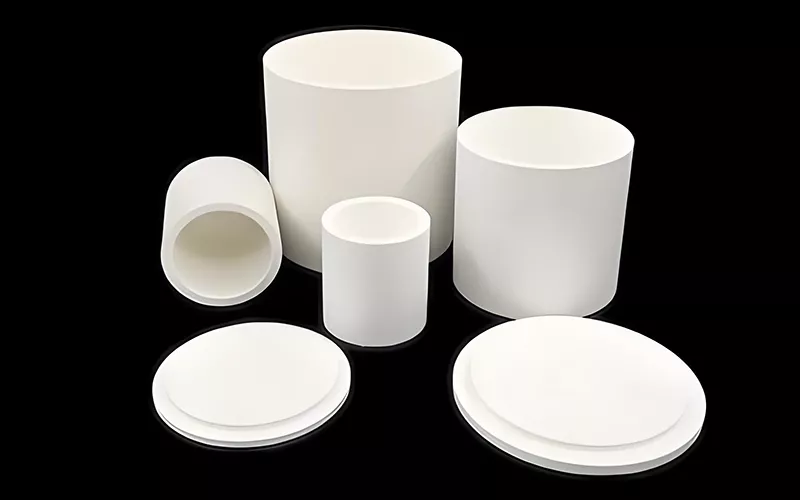Ceramic crucibles are containers with high melting points and high temperature resistance. They combine chemical stability with a low coefficient of thermal expansion, making them essential tools for extremely high-temperature applications in laboratories, metallurgy, semiconductor manufacturing, and other fields.
Ceramic crucibles are primarily made from advanced ceramics such as aluminiumoxide, boornitride, En zirkoonoxide. In this article, we’ll explore ceramic crucible material selection, key characteristics, and service life to help you select the most suitable crucible for your high-temperature application.

What Are The Materials of Ceramic Crucible?
Alumina-kroes
Alumina ceramic crucibles are primarily made of 99.7% pure aluminum oxide. Did you know? During the production process, many manufacturers, such as GORGEOUS, add small amounts of magnesium oxide (MgO) and silicon dioxide (SiO2) to impart superior physical and chemical properties to the crucibles.
Key Features: High-Temperature Resistance - Alumina crucibles can withstand temperatures of approximately 1700°C in a redox atmosphere. While offering superior performance, alumina crucibles are also price-competitive, making them the preferred material for many manufacturers.
Applications: Alumina crucibles are primarily used in laboratory and industrial metallurgy, heating, and chemical reactions.
Advantages: Alumina crucibles are one of the most economical ceramic crucibles on the market. Alumina’s high melting point and low thermal expansion coefficient make them resistant to cracking. They are ideal reaction vessels for weakly alkaline substances.
Limitations: Strongly corrosive substances, such as the strong base sodium hydroxide (NaOH), can severely damage alumina crucibles. For these materials, GORGEOUS recommends using a crucible material with strong corrosion resistance instead of alumina crucible.
Zirkonia-kroes
Zirconia crucibles are primarily made of high-purity zirconium oxide. Their exceptionally high temperature resistance and chemical stability make them ideal for extremely high-temperature melting processes.
Key Features: Zirconia crucibles boast robust high-temperature resistance, capable of withstanding temperatures up to 2000°C, making them ideal for melting precious metals such as platinum (Pt) and palladium (Pd).
Zirconium oxide also possesses excellent chemical resistance, maintaining a stable structure even in harsh environments with strong acids and alkalis, making it an ideal crucible material for processes prone to corrosion.
Applications: Zirconia crucibles are primarily used in precious metal melting and certain processes involving high-melting-point materials.
Zirconia Toughened Alumina Crucible (ZTA Crucible)
Zirconia-toughened alumina crucibles (ZTA) are primarily made of 90% alumina and 10% zirconia. This ceramic material combines the advantages of both alumina and zirconia, offering excellent high-temperature resistance and high toughness.
Key Features:
High Toughness - The addition of zirconia significantly improves the crucible’s crack and wear resistance, reducing damage caused by high temperatures and mechanical shock.
High-Temperature Resistance - ZTA crucibles can withstand temperatures up to 1700°C and operate stably in high-temperature environments.
Thermal Shock Resistance - Compared to pure alumina crucibles, ZTA crucibles offer higher thermal shock resistance, are more stable under severe temperature fluctuations, and are less prone to cracking.
Applications: These crucibles are primarily used in processes requiring high mechanical strength and high-temperature stability.
Boron Nitride Crucible (PBN Crucible)
Boron nitride crucibles are specially designed for use at extremely high temperatures. Their primary component is pyrolytic boron nitride.
Key Features:
High-Temperature Resistance - Boron nitride crucibles offer exceptional high-temperature resistance. In a protective atmosphere, they can reach temperatures of up to 2100°C and remain stable. They will not melt or react chemically with the substrate at extremely high temperatures.
Thermal Conductivity - Boron nitride crucibles have excellent thermal conductivity, allowing them to quickly dissipate heat, effectively preventing localized overheating, thermal stress, and thermal damage.
Low Thermal Expansion Coefficient - Boron nitride has a low thermal expansion coefficient, effectively reducing the risk of crucible cracking in high-temperature processes requiring rapid cooling or heating.
Applications: Boron nitride crucibles are primarily used in high-temperature processes such as semiconductor manufacturing and metal smelting. In the semiconductor industry, they are often used in chemical vapor deposition (CVD), crystal growth, and high-temperature evaporation.
Other Ceramic Materials
In addition to the common ceramic materials mentioned above, there are also high-quality crucible materials such as magnesium oxide and beryllium oxide. They all have excellent high-temperature performance and are essential crucible container materials for many metal smelting and laboratories.
How To Ensure The Service Life of The Crucible?
If you want your crucible to have better performance and service life, you’d better do the following:
Storage:
It is best to store used crucibles in a dry, clean environment to prevent them from absorbing moisture and contamination. Storing crucibles near chemicals or in areas of high humidity should be avoided.
Operate:
You should use appropriate tools to operate the crucible, avoid direct contact with your hands, and check for cracks or damage after use.
Cleaning:
You should clean the crucible thoroughly after each use. All residues should be removed and care should be taken to allow it to cool properly before cleaning to prevent thermal shock and cracking.
Veelgestelde vragen
1. What is a crucible?
A crucible is a container designed for use at extremely high temperatures, primarily used for metal smelting and chemical reactions.
2. What is the melting point of a ceramic crucible?
The melting point of a ceramic crucible depends mainly on the material used. For example, an alumina crucible can withstand temperatures between 1650°C and 1700°C, while a zirconia crucible can withstand temperatures up to 2000°C.
3. What are the uses of ceramic crucibles in chemistry?
Ceramic crucibles are often used for high-temperature metal smelting, as chemical reaction containers, material processing containers, etc.
4. What is the function of ceramic crucible?
Ceramic crucible is mainly used for high temperature heating applications, melting or refining materials, etc. It can also act as a container for some chemical reactions.
5. What are the material properties of ceramic crucibles?
Ceramic materials have the characteristics of high melting point, low thermal expansion coefficient, good thermal stability, and chemical corrosion resistance.
6. Can ceramic crucibles be used to melt strong alkaline substances?
This mainly depends on the material of the crucible. Generally, we do not recommend that you use alumina crucibles to melt strong alkaline substances such as sodium hydroxide (NaOH) and sodium peroxide (Na₂O₂), as these substances may corrode the crucible.
7. What is the difference between porcelain crucible and ceramic crucible?
Porcelain crucible usually refers to a crucible made of porcelain material. Ceramic crucible has stronger performance than traditional porcelain crucible, can withstand higher temperature, and has stronger mechanical properties.
8. How to heat a ceramic crucible?
When heating a ceramic crucible, you should choose a suitable heating method according to the characteristics of the crucible material. It should be noted that sudden cooling or heating should be avoided during heating, which may cause the crucible to crack.
9. What are the maintenance methods for ceramic crucibles?
After using the crucible, you should clean it thoroughly to remove the residue, and use an appropriate cleaning solution to clean it, and finally rinse it with pure water and dry it for later use.
Conclusie
Ceramic crucibles are indispensable tools in modern chemistry and metallurgy. Capable of operating in extreme temperatures and harsh chemical environments, they play a key role in a wide range of scientific and industrial applications. GORGEOUS, a leading international supplier of advanced ceramics, offers custom-made ceramic crucibles in a variety of materials. Thank you for reading this article, and we hope you find it helpful.